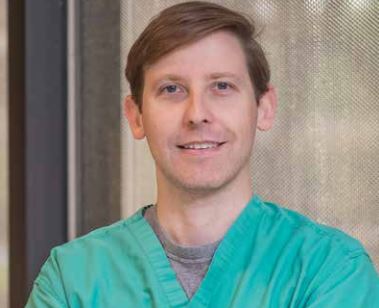Dr. Benjamin Henderson, M.D.
Prolonging Life for Those with Liver Cancer
 Radioembolization is a minimally invasive procedure that combines embolization and radiation therapy to treat liver cancer. Tiny glass or resin beads filled with the radioactive isotope Yttrium-90 are placed inside the blood vessels that feed the tumor. These tiny beads block the supply of blood to the cancer cells and deliver a high dose of radiation to the tumor, while sparing normal tissue.
Radioembolization is a minimally invasive procedure that combines embolization and radiation therapy to treat liver cancer. Tiny glass or resin beads filled with the radioactive isotope Yttrium-90 are placed inside the blood vessels that feed the tumor. These tiny beads block the supply of blood to the cancer cells and deliver a high dose of radiation to the tumor, while sparing normal tissue.
“Radioembolization is used to treat tumors that were initially formed in the liver or have spread (or metastasized) to the liver from another part of the body,” says Dr. Benjamin Henderson, a board-certified specialist in diagnostic radiology, and vascular and interventional radiology. “It is a palliative treatment, which means it does not typically provide a cure but instead helps slow down the growth of the disease and alleviate symptoms. The procedure is an option for patients who are not candidates for other treatments, including surgery or liver transplantation.”
HOW IT WORKS
Radiation therapy uses a certain type of energy, called beta radiation, to kill cancer cells and shrink tumors. In embolization, blood vessels or malformations within blood vessels are blocked off to prevent blood flow. The combination of these two is radioembolization, wherein the microspheres (the tiny glass or resin beads) are placed inside blood vessels so that they can block the supply of blood to the cancer cells. Once these microspheres filled with Y-90 are lodged at the tumor site, they deliver a high dose of radiation to the tumor, while avoiding the normal tissues.
Although radioembolization is a treatment, not a cure, the majority of patients will see stability or improvement in liver disease. “It can help to extend the lives of patients with inoperable tumors from months to years and improve their quality of life,” Dr. Henderson says. “In some cases, it may allow for more curative options such as ablation, surgery or liver transplantation.”
EXPLAINING THE PROCEDURE
Using x-ray imaging and a contrast material to visualize the blood vessels, the interventional radiologist inserts a catheter through the skin into a blood vessel and then advances it to the treatment site. The radiation-filled microspheres are then inserted through the catheter and advanced to the blood vessels supplying the tumor with blood. Once the microspheres are lodged at the tumor site, they deliver a high dosage of radiation directly to the cancer cells. The microspheres will block the flow of blood to the tumor, depriving the diseased cells of the oxygen and nutrients needed to grow.
“There are two primary blood vessels that bring blood to the liver,” Dr. Henderson says. “Normal liver tissue receives about 75 percent of its blood supply from the portal vein and about 25 percent from the hepatic artery. A tumor that grows in the liver receives most of its blood supply from the hepatic artery. Because the radioactive microspheres are delivered through the hepatic artery, they can reach the tumor directly, while sparing most of the healthy liver tissue.”
In patients with tumors in both lobes of their liver, this procedure can be done for one side and then the other. The radiation from Y-90 continually decreases over a two-week period and disappears after 30 days; however, the tiny microspheres remain in the liver without causing any problems.
A native of Shreveport, Louisiana, and a Louisiana State University health graduate, Dr. Henderson earned his medical doctorate at LSU Health Science Center Shreveport. He completed his residency in diagnostic radiology at LSU Shreveport and then a fellowship in interventional radiology at the Medical University of South Carolina in Charleston.
On why he became a doctor: “My father is an ophthalmologist, and I have always respected him,” Dr. Henderson says. “I have always thought being a doctor is a noble profession. Out of his four children, three of us became doctors. That shows what a great influence my father had on us.”
On his advice for patients: “I would suggest people ask more questions, especially if there is something you don’t understand,” he says. “Patients may not realize it, but doctors like questions because they keep us on our toes. Tell your oncologist, ‘I just read about Y-90 — can you explain to me how it works?’”
Dr. Benjamin Henderson, M.D.
Radiology and Interventional Associates of Metairie
East Jefferson General Hospital
4200 Houma Blvd.
Metairie, LA 70006
(504) 503-4314
ejgh.org
Doctor of Medicine: Louisiana State University, Shreveport
Residency in Diagnostic Radiology: Louisiana State University, Shreveport
Fellowship in Vascular and Interventional Radiology: Medical University of South Carolina
Board Certification: Diagnostic Radiology
